Luxury tobacco brands like Sobranie, Dunhill, and Davidoff have centuries-old roots in European craftsmanship, aristocratic patronage, and royal endorsement. Originating in the 19th and early 20th centuries, these brands gained prestige through exquisite packaging, limited editions, and serving high society. Their European heritage, especially connections to royal families, helped establish their status worldwide. If you explore further, you’ll discover how these brands evolved from tobacco into symbols of luxury and lifestyle.
Key Takeaways
- European luxury tobacco brands like Sobranie, Dunhill, and Davidoff originated in the 19th and early 20th centuries, emphasizing craftsmanship and heritage.
- Sobranie was founded in 1879 in London by Russian immigrant Albert Weinberg, gaining fame for high-society cigarettes.
- Dunhill, established in 1907, became a British luxury icon known for innovative packaging and premium quality.
- Davidoff, founded in Switzerland in 1967, initially focused on cigars before expanding into high-end cigarettes.
- Royal endorsement and European origins, especially German and Swiss manufacturing, significantly elevated these brands’ prestige and global reputation.
Origins and Heritage of European Luxury Tobacco Brands
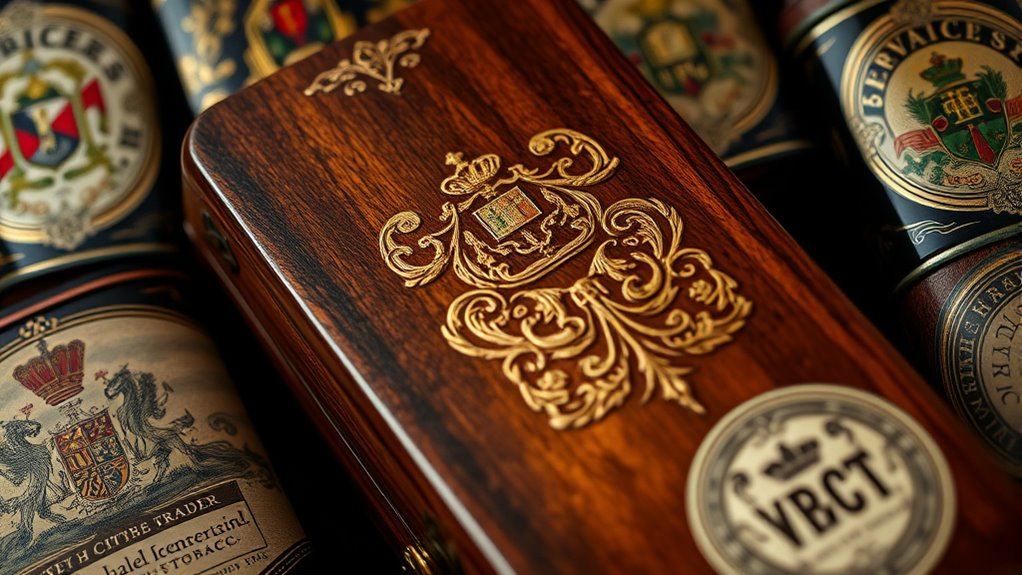
European luxury tobacco brands like Sobranie, Dunhill, and Davidoff have deep roots that trace back to the 19th and early 20th centuries, reflecting a long-standing tradition of craftsmanship. Their heritage is built on a commitment to quality, innovation, and elegance, which continues to define European luxury. Sobranie, founded in 1879 in London by Russian immigrant Albert Weinberg, gained fame for its high-society cigarettes. Dunhill, established in 1907, became a symbol of British luxury through premium quality and inventive packaging. Davidoff, founded in Switzerland in 1967, initially focused on cigars before expanding into premium cigarettes, emphasizing craftsmanship and European tradition. These brands leverage their rich history and European manufacturing prestige to reinforce their status as icons of luxury. Additionally, their rich heritage is often highlighted in marketing to appeal to discerning consumers seeking timeless elegance, further cementing their reputation as symbols of luxury craftsmanship. A focus on European manufacturing further distinguishes these brands in the global market.
The Rise of European Royalty in the Tobacco Industry
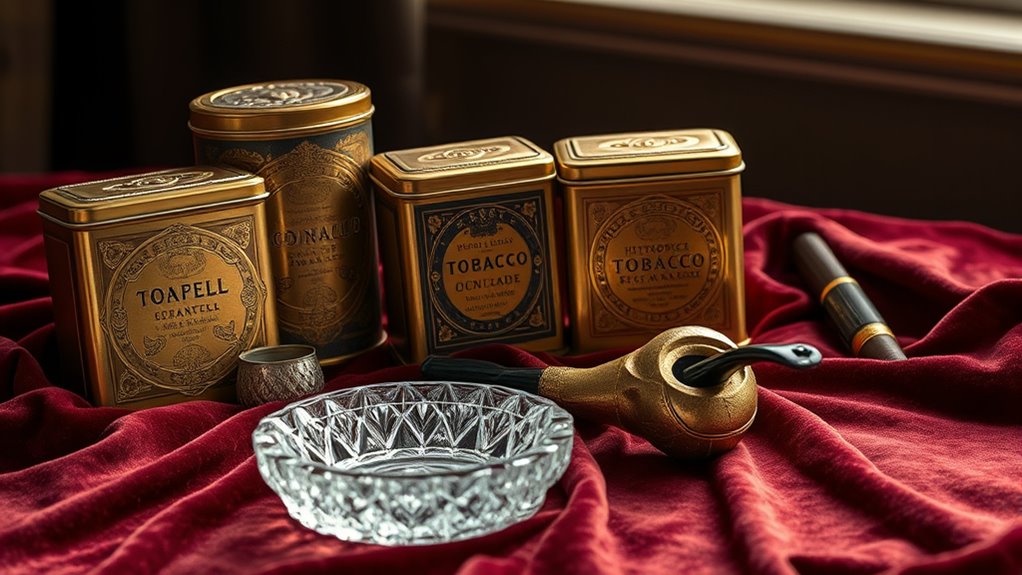
Royal families across Europe have long been intertwined with the luxury tobacco industry, shaping its image of exclusivity and prestige. European royalty, such as the Bernadotte, Bourbon, and Windsor houses, directly influenced luxury tobacco brands’ branding and reputation. Their involvement elevated these brands within aristocratic circles and reinforced their status symbols. Consider these key points:
European royal families helped elevate luxury tobacco brands to symbols of aristocratic prestige and tradition.
- European royalty’s endorsement helped transform brands like Dunhill, Sobranie, and Ducal into symbols of elite status.
- Royal patronage fostered a close link between aristocratic circles and premium tobacco products.
- European origins, especially “Made in Germany,” gained additional prestige through royal associations, boosting global appeal.
This royal connection cemented a legacy of refinement and tradition that continues to define these luxury tobacco brands today.
Iconic Brands That Define Luxury Cigarettes

You recognize the names Sobranie, Dunhill, and Davidoff as symbols of luxury and refinement. Their rich heritage and European roots have helped shape their prestigious reputation worldwide. These brands continue to embody craftsmanship, exclusivity, and social status in the world of high-end cigarettes. Moreover, their iconic packaging and limited editions further reinforce their status as luxury tobacco brands.
Heritage and Prestige
Heritage and prestige are at the core of the world’s most iconic luxury cigarette brands, shaping their identity through centuries of craftsmanship and exclusivity. These brands, like Sobranie, Dunhill, and Davidoff, have deep roots that reinforce their status. Consider these key elements:
- They showcase a rich heritage, with histories dating back to the 19th and early 20th centuries. Historical significance is often preserved through exclusive traditions and meticulous quality control, ensuring their status endures over generations. Many of these brands have maintained timeless appeal by upholding classic production methods and design standards.
- Their prestige stems from serving royalty, aristocrats, and high society worldwide.
- Craftsmanship remains central, emphasizing artisanal production and meticulous detail.
- The heritage of these brands is often preserved through exclusive traditions and meticulous quality control, ensuring their status endures over generations. Additionally, their commitment to luxury branding emphasizes exclusivity and prestige, reinforcing their position in the premium market.
This combination of heritage, prestige, and craftsmanship ensures these brands continue to symbolize luxury and refinement, maintaining their revered status in the world of premium cigarettes. Their legacy is a testament to timeless quality and exclusivity.
European Influence and Status
Have you ever noticed how European luxury cigarette brands like Sobranie, Dunhill, and Davidoff continue to define the pinnacle of sophistication? Their European heritage, rooted in centuries of craftsmanship, adds to their prestige. These brands have long been associated with aristocratic and high-society circles, reinforcing their status as symbols of exclusivity. The “Made in Europe” label, especially from Germany and Switzerland, is highly valued worldwide, particularly in Asian markets, for representing top-tier quality and reliability. European royal houses like Bernadotte, Bourbon, and Windsor have historically linked to these brands, further elevating their prestige. Through premium packaging, limited editions, and artisanal manufacturing, European luxury cigarette brands cultivate an image of timeless elegance and social standing. Incorporating password strength evaluation ensures secure access, reflecting the importance of brand reputation and trustworthiness that these brands embody. Additionally, the heritage of European craftsmanship and luxury branding continues to influence modern perceptions of quality and exclusivity. The consistency of European standards contributes to consumer confidence and the enduring appeal of these brands across generations.
Craftsmanship and Packaging: The Hallmarks of Elegance
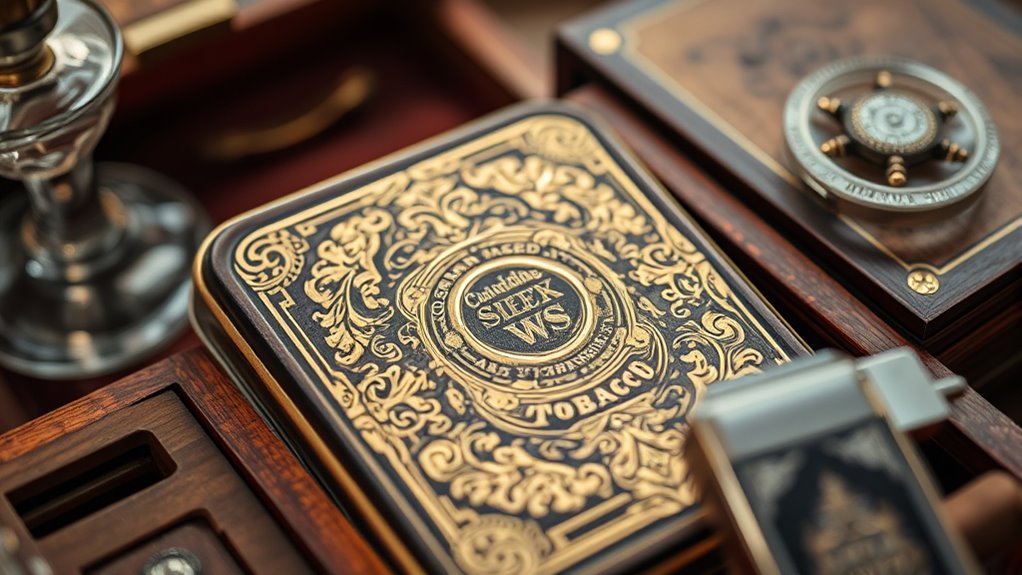
Craftsmanship and packaging are at the heart of what makes luxury tobacco brands stand out, transforming a simple act into an indulgent experience. Your senses are engaged through meticulous craftsmanship, such as hand-rolling and artisanal techniques that honor tradition. Premium packaging elevates this experience with:
- Intricate designs and embossed logos that showcase attention to detail
- Vintage-inspired packaging highlighting heritage and authenticity
- Innovative solutions like collectible boxes and limited editions that boost desirability
These elements reinforce the exclusivity and refined image of luxury tobacco products. By emphasizing craftsmanship and heritage, brands create a sensory journey that turns everyday smoking into a statement of elegance and status. It’s not just tobacco; it’s an art form. Recognizing the importance of emotional support in maintaining brand loyalty, some brands also incorporate storytelling and cultural narratives to deepen consumer connection. Additionally, the use of heritage preservation techniques helps sustain the legacy and authenticity associated with luxury tobacco brands. Incorporating attention to detail in every aspect of design and production further distinguishes these brands from standard offerings, emphasizing their commitment to quality and tradition. Moreover, integrating craftsmanship techniques elevates the overall perception of luxury and exclusivity.
Regional Preferences and the European Influence in Asia
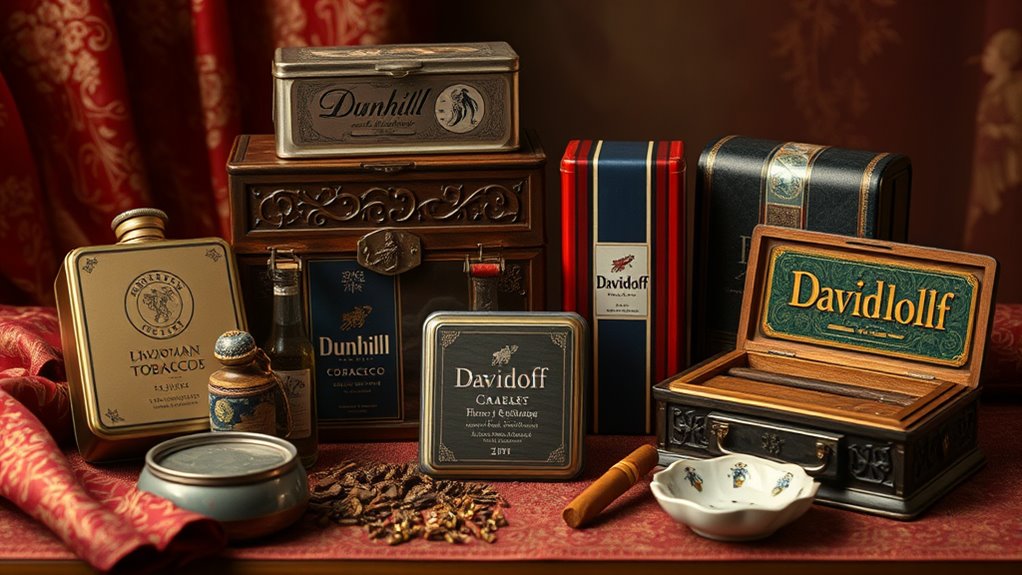
European luxury cigarette brands like Sobranie and Tradition hold a strong appeal in Asian markets, driven by perceptions of quality and prestige. The “Made in Europe” label, especially “Made in Germany,” signals high standards and influences Asian consumers’ preferences. European brands such as Sobranie Laube are particularly favored in travel retail and among affluent buyers. Their heritage, craftsmanship, and European manufacturing standards reinforce their desirability. Asian markets see these brands as symbols of reliability and exclusivity, fueling demand. The regional success of European luxury tobacco relies heavily on these perceptions of quality, prestige, and tradition. Here’s a quick overview:
| Aspect | Impact |
|---|---|
| Heritage | Boosts exclusivity |
| Manufacturing | Signifies quality |
| Travel retail | Enhances visibility |
| Perception | Drives demand |
| Prestige | Reinforces loyalty |
The Evolution of Luxury Cigarette Marketing Strategies

Luxury cigarette brands have continually evolved their marketing strategies to maintain their aura of exclusivity and appeal to affluent consumers. They’ve relied on sophisticated packaging, heritage branding, and endorsements from high society to craft an elite image. To stand out, they focus on:
- Highlighting craftsmanship and social status in their campaigns
- Creating scarcity through limited-edition releases
- Leveraging their heritage and origins to attract international markets
Their advertising shifted from traditional print and outdoor ads to exclusive events and personalized experiences, reinforcing their elite positioning. Iconic symbols, storytelling, and associations with royalty and aristocracy have been central to their strategy. Additionally, emphasizing brand storytelling and the narrative of exclusivity helps solidify their aspirational status. This evolution guarantees that luxury brands stay relevant while preserving their timeless, aspirational appeal. Recognizing the importance of brand heritage in maintaining customer loyalty, many brands emphasize their long-standing history to appeal to consumers’ desire for authenticity.
Transition From Tobacco to Broader Luxury Goods
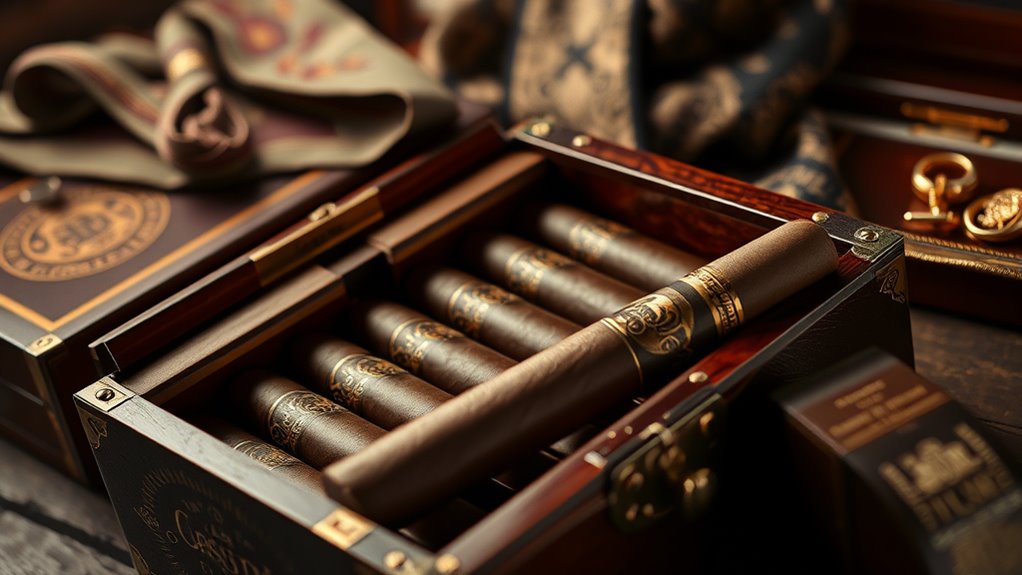
As smoking declines and health regulations tighten, many luxury tobacco brands are shifting their focus to broader luxury goods. They leverage their heritage, craftsmanship, and exclusivity to rebrand and diversify into jewelry, fashion, and other high-end markets. This strategic move helps maintain their prestige and adapt to changing industry landscapes. Additionally, some brands are exploring entertainment and parks collaborations and themed experiences to appeal to modern consumers.
Heritage and Brand Evolution
Many prestigious tobacco brands have evolved beyond their original products by emphasizing their rich heritage and artisanal craftsmanship. The heritage helps them reinforce their brand evolution, creating a strong connection to luxury tobacco. To stand out, these brands focus on: 1. Leveraging their history from the 19th and early 20th centuries to evoke exclusivity. 2. Serving high society and aristocracy, reinforcing their status as symbols of tradition. 3. Expanding into premium cigars and upscale packaging, aligning with cultural and artistic pursuits. 4. Incorporating innovative products such as luxury accessories and lifestyle branding to broaden their appeal to modern consumers. Recognizing the importance of brand storytelling allows these companies to deepen consumer engagement and preserve their legacy. Additionally, many of these brands emphasize their heritage and history as a core aspect of their marketing strategy to maintain an aura of exclusivity and authenticity, which is further supported by emotional intelligence strategies that foster consumer loyalty.
Strategic Diversification Moves
Heritage and craftsmanship that once defined tobacco brands now serve as a foundation for their strategic expansion into broader luxury markets. Recognizing the need for strategic diversification, a tobacco company like Richemont shifted its focus toward luxury brands to stay relevant and capitalize on new opportunities. In 1968, Anton Rupert’s decision to acquire Cartier marked the start of this transformation. By 1988, Johann Rupert officially established Richemont to concentrate on high-end jewelry and watch brands, moving away from tobacco manufacturing. Strategic diversification continued with acquisitions of iconic names like Vacheron Constantin and Van Cleef & Arpels, broadening the company’s reach within the luxury sector. This shift allowed the tobacco company to leverage its heritage and exclusivity, positioning itself as a major player in the luxury goods industry.
Industry Prestige Reassignment
How do historic tobacco brands maintain their prestige in an evolving luxury market? They achieve this through strategic brand repositioning, leveraging their heritage to appeal to a broader audience. Here are three key strategies:
- Expanding into luxury lifestyle products like accessories and fragrances.
- Diversifying revenue streams amid declining smoking rates and stricter regulations.
- Reinforcing their exclusivity by branding in luxury hotels and other high-end sectors.
- Implementing residency requirements and other legal strategies to sustain their brand image across different markets. Additionally, embracing brand heritage allows these companies to craft a narrative of timeless elegance that resonates with modern luxury consumers.
The Contemporary Market and Future Trends in Luxury Tobacco
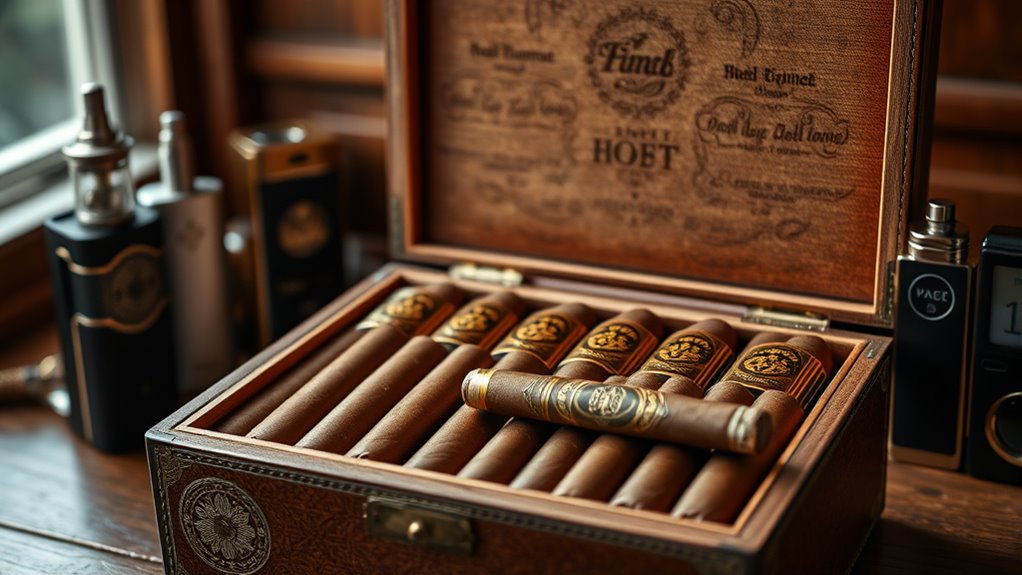
The luxury tobacco market today is driven by brands that emphasize craftsmanship, exclusivity, and a rich history, such as Sobranie, Davidoff, and Montecristo. These heritage brands leverage their legacy to appeal to discerning consumers, while product innovation helps them stay relevant amid regulatory challenges. Limited editions and artisanal methods create scarcity, boosting desirability. Meanwhile, the rise of premium cigar and cigarette brands in Asian markets reflects shifting consumer preferences toward luxury and status symbols. To stay ahead, brands are blending tradition with modern lifestyle branding through collaborations with fashion and hospitality sectors.
| Market Focus | Strategies |
|---|---|
| Heritage & craftsmanship | Limited editions, artisanal production |
| Innovation & differentiation | Packaging, product variety |
| Regional growth | Asian luxury markets |
| Lifestyle integration | Collaborations with fashion & hospitality |
Frequently Asked Questions
What Is the Most Luxurious Cigarette Brand?
You’re asking about the most luxurious cigarette brand. Based on their reputation, Sobranie stands out with its rich heritage, exclusive appeal, and high-quality craftsmanship. Its iconic Black Russian and Gold lines are known for refined taste and sophisticated branding. European brands like Dunhill and Davidoff also rank high, emphasizing heritage and craftsmanship. Ultimately, your choice depends on your appreciation for tradition, exclusivity, and premium quality.
Which Cigarette Brands No Longer Exist?
Imagine stepping into a smoky jazz club in the 1920s—some brands like Laika, Lucky Strike Clove, Memphis, and Eagle 20s once filled the air. Today, you can’t find them anymore; they’ve vanished due to regulatory changes, market shifts, or mergers. Brands like Laika and Memphis ceased production, while others like Lucky Strike Clove and Eagle 20s are relics of a bygone era, no longer available to modern smokers.
What Is the Richest Tobacco Company in the World?
You’re asking which tobacco company is the richest. Right now, Philip Morris International holds that title, with over $80 billion in revenue in 2022. It dominates the global market, thanks to its extensive product portfolio and international reach. You should note that its size and profits make it the most financially powerful tobacco company worldwide, surpassing competitors like British American Tobacco and Japan Tobacco.
What Is the Oldest Tobacco Company in the US?
Think of the past as a guiding light illuminating your curiosity. The oldest tobacco company in the U.S. is Liggett & Myers, founded in 1842 in New York City. You see its roots as a sturdy oak, standing tall through history’s storms. Acquiring British American Tobacco in 1999, it symbolized the enduring strength of tradition. Its legacy reminds you of resilience and the deep roots of American industry.
Conclusion
You might think luxury tobacco is all about tradition and elegance, but today’s market blends heritage with innovation. While the craftsmanship and regal branding evoke timeless sophistication, modern trends push boundaries toward exclusivity and lifestyle. Just as historic brands once symbolized status, contemporary choices reflect a dynamic fusion of history and modern luxury. So, as you explore this world, remember—what was once a simple indulgence now stands at the crossroads of tradition and trend.










